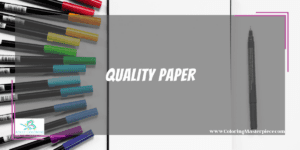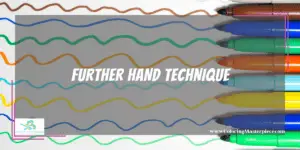From Crayola to Copic, markers continue to be a popular medium due to their deep colors and smooth textures. However, the highly saturated ink comes at a cost that often comes in the form of streaking. Inconsistent overlapping layers of ink resulting in streaks of heavier pigment across the coloring area.
To color markers without streaking, you first need to focus on the paper instead of the marker. Coloring on a thicker paper such as card stock with a tighter weave and preferably matte or slightly glossy finish will massively prevent streaking as you color. Secondly, prioritizing an oval motion with your hand instead of a zig-zag pattern will also help remove inconsistencies in pressure and overlapping layers.
When it comes to the markers themselves, abiding by the Three Tone Rule and blending your tonal options will do more for removing streaks than buying all new markers will. Blending can be done by color-merging or using a blending solution.
Quality Paper

Right away aim for slow-dry paper. Paper that absorbs ink too quickly is what shows the lines of each marker stroke. A slow-drying paper such as a matte finish or slightly glossy finish over paper allows the marker ink to pool on the surface of the paper before setting in. Pooling allows the ink to mix and even out as you color before settling into the page. When the ink dries immediately into the paper, the next overlapping layer is surely bound to show streaking.
Paper with a loose weave is highly absorbent and though great for dry mediums such as colored pencils, chalk, or charcoal. Wet mediums such as markers, watercolors, and oils benefit from a tighter weave since the tighter weave will allow the ink to sit and stay wet during the blending process before settling into the page. As a rule of thumb: dry mediums stay dry during blending, and wet mediums stay wet during blending. There are some exceptions such as additive solvents, but for covering the basics, the mantra holds.
Ovals, not Zig-Zag
When it comes to your hands a circular or oval motion will best set you up for success. The circular motion increases your chances of most evenly applying ink, similar to how a cook melts butter in a pan, you want to push the ink around inside the color area like softened butter covering every spot of surface in the pan.
Zig-zagging isn’t completely disbarred, however, the fast back-and-forth motion creates a lot of inconsistent layers while overlapping. Coloring slow zig-zags may help but it still doesn’t completely solve the unbalanced layering, as well as circular coloring does.
The 3-Tone Rule
The three-tone rule breaks down to this: for every color you’re going to use, you need three tones of that color in a dark, medium, and light tone spread. For example, if I need some blue for a lake color, then I need at least three blue markers of varying tones.
Some brands like Copic make an organized numbering system for each of the markers to help colorists keep track of their color values for each marker. Going back to the lake example, instead of just using the blue marker for the whole lake, I’m going to use B04 as my light blue value, B05 as my medium value, and B06 as my dark value. The B stands for blue with Copic markers and the number indicates different ink shades of that blue. By coloring my lake with three tones, letting the ink of each marker pool and blend into each other before drying against the paper, I’ve both decreased streaking in the picture and added a deeply saturated look to a smooth body of water.
The tips listed above can be used with just about any set of markers and show an immediate improvement. However, sometimes a product can only be as good as its manufacture, in which case, it helps to know what to look for in a marker when comes to the time for a marker upgrade.
Choosing The Right Markers
In general, there are two kinds of markers alcohol-based and water-based.
- Alcohol-based markers dry faster and are usually more popular in the artist community. Popular brands include Copic, Uni-Posca, Arteza, and Ohuhu. Typically colorists prefer alcohol-based markers because of their more saturated ink and thus more vibrant appearance for most colors. Most of the time, if you’re looking at professionally done marker art, it was probably done with an alcohol-based marker.
- Water-based markers on the other hand dry slower giving the colorist more time to blend and pool inks. This is a less punishing marker to color with since the ink is more soluble and allows the colorist more time to blend inks to get rid of or reduce streaking. However, without a constant touch to get the most out of water-based markers, inconsistencies can arise during the pooling process as well as streaking while coloring.
Further Hand Technique

No marker is completely streak-free by design. To improve coloring consistency, improve your technique! Streaking is most common in larger areas of coloring. Best to practice on smaller pictures and gradually move up to larger pieces.
To help create gradients and make blending much easier, artists typically use color merging in combination with the three-tone rule to create vibrant and deep color palettes with the maker. Color merging is done by layering the next darkest tone of the three-tone rule on the outer edges of the lighter-colored area. Going back to the lake example, the B04 marker would be the first layer. Next, I would color the edges over the B04 with the next darker tone — technically the medium tone in the tree tone rule — marker B05, blending the medium tone into the lighter tone through the color merging edge. Lastly, apply the darkest tone B06 in this example, over the outer edges of the B04 marker and blend as previously done.
Additionally, Flicking the marker into merging colors also blends the pooling ink into each other through the merging coloring zones while still creating a natural lightening effect (lighter in color, not thunder and storms) since the pressure of the marker naturally lets up as you flick into the lighter shade.
Using Additives: Additives such as rubbing alcohol, water, or blending solution can be used after the ink has dried on the page. These liquid-based additives are excellent for blending and smoothing out streak lines while finishing with a richer texture.
After the ink has dried chances of blending colors and smoothing out streaks become increasingly difficult since the ink is unable to move. However, for alcohol-based markers, colorists can use a Q-tip dipped in rubbing alcohol and blend over streak lines by gently smudging or flicking the dipped Q-tip over the marker or merging the color zone. The wet surface of the Q-tip rejuvenates the alcohol binder allowing the ink to spread over the page as you lightly brush.
The same effect can be achieved with water-based markers by smudging the streak lines with a Q-tip dipped in water as opposed to alcohol. Be sure to match the correct additive with the corresponding solvent base.
Not an additive but just as important, note that artists often advise using a lighter shade of an intended color since added layers of ink will naturally darken the tone of the ink. Strategically layering ink coats also provides the colorist with more temperature options. Combined with the 3-Tone Rule and Merging Color Areas, the monochromatic gradients available to an artist can easily blend away any streaking color areas.
Frequently Asked Questions
What Coloring Books Should I Look For If Coloring With Markers?
Unfortunately, not all coloring books are equal in quality and many of them contain paper no better than standard copy paper. If you’re looking for a book with fun designs to color and a trusted quality paper to color on here are three suggestions to point you in the right direction.
- Arteza Coloring Book For Adults Floral and Mandala Designs boasts thick artist-grade paper for 144 unique floral and mandala designs. Available through Amazon for $15.99. Link Here
- Ultimate Tattoo Coloring Book for Adults comes with a thick 300 pages of quality paper and intense designs of sugar skulls, hearts, roses, and more that are fun for any age of colorist. Available through Amazon for $14.30. Link Here.
- Lastly, for some of the best quality paper in a book the ColorIt Colorful Flowers Adult Coloring Book comes spiral-bound with 50 pages of fun flower designs. Available through Amazon for $19.99. Link Here.
What Markers Do You Recommend?
When it comes to the artist community there are a few clear-cut go-to’s in the markers game. For a shortlist, we recommend the following brands for both alcohol and water-based markers.
- Number one Copic Markers, a clear staple in alcohol-based markers for a litany of reasons including their high-quality ink, and brush-nip marker tip.
- Number two for alcohol-based markers and probably the best in terms of watercolor markers Ohuhu is available through Amazon here.
- Rounding it out with number three, we recommend Arteza Markers also available through Amazon as well as our very own review of Arteza Markers here.
Maximize the benefits of coloring with my free adult coloring eBook and by signing up for my email newsletter HERE!
Disclaimer: The information provided by ColoringMasterpiece.com (“The Site”) is for general informational purposes only. All information on the Site is provided in good faith, however, we make no representation or warranty of any kind, express or implied, regarding the accuracy, adequacy, validity, reliability, availability, or completeness of any information on the Site. Under no circumstance shall we have any liability to you for any loss or damage of any kind incurred as a result of the use of the Site or Reliance on any information provided on the Site. Your use of the Site and your reliance on any information on the Site is solely at your own risk. This blog post is for educational purposes only and does not constitute legal advice. Please consult a legal expert to address your specific needs.
Terms and Conditions: https://coloringmasterpiece.com/terms-and-conditions/

